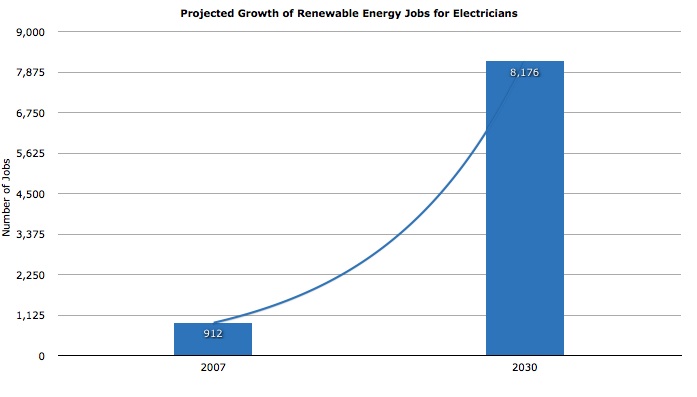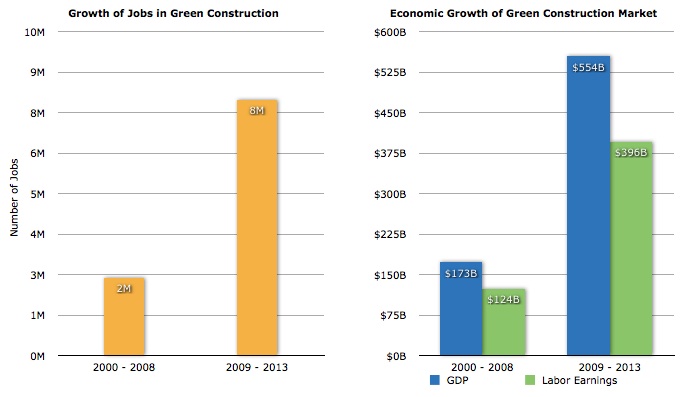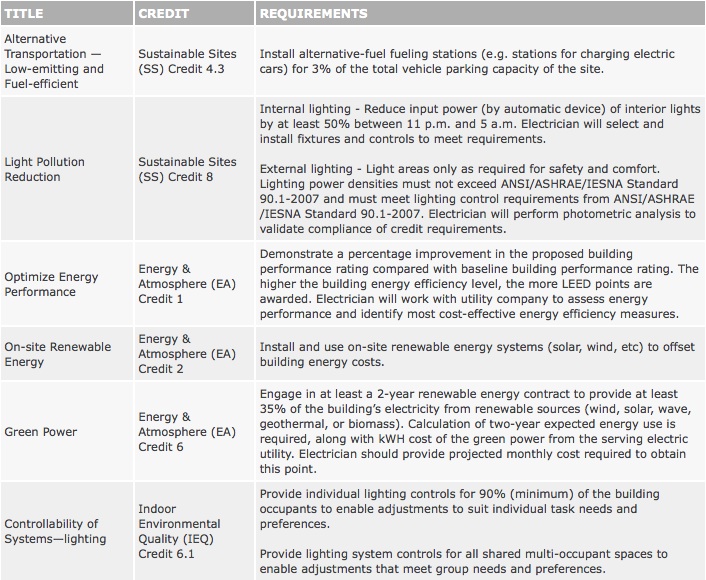
By Houston Neal
In the next 10 to 20 years, “electrical contractor” will no longer be a suitable job title for electricians. They will transition into “energy contractors” to support the fast-growing green construction market.
We see this as a coming renaissance in electrical contracting. There has been a revival of interest in the electrical trade as home owners and corporations adopt alternative methods (e.g. solar, wind, etc) to power buildings. What’s driving this? Federal incentives, lower material costs and savings from reduced energy spending.
 A study by the American Solar Energy Society projects renewable energy jobs for electricians to grow approximately 900% by 2030, just in the state of Colorado (See Figure 1, “Projected Growth of Renewable Energy Jobs for Electricians”).
A study by the American Solar Energy Society projects renewable energy jobs for electricians to grow approximately 900% by 2030, just in the state of Colorado (See Figure 1, “Projected Growth of Renewable Energy Jobs for Electricians”).
To take advantage of upcoming opportunities, electricians will need to “green” their skill-set and re-brand themselves. We’ll share more on this later. First, let’s take a look at the trends driving this change.
Green construction is on the rise
According to a 2009 Booz Allen Hamilton study, green construction will skyrocket over the next five years. The report projects green construction to generate $554 billion dollars in GDP, provide $396 billion in labor earnings and support or create over 7.9 million jobs from 2009 to 2013 (Figure 2, “Growth of Jobs in Green Construction” and “Economic Growth of Green Construction Market”). These figures are way up from the previous 8-year period. From 2000-2008, GDP from green construction was just $173 billion, labor earnings was $123 billion and number of jobs created was 2.4 million.
 This growth comes directly from increased demand for green buildings, which is largely driven by cost savings from reduced property operating expenses, and by new regulations from federal legislation (e.g. American Clean Energy and Security Act).
This growth comes directly from increased demand for green buildings, which is largely driven by cost savings from reduced property operating expenses, and by new regulations from federal legislation (e.g. American Clean Energy and Security Act).
Clearly, environmentally friendly construction affects the architecture engineering construction (AEC) industry collectively. But how will this impact electricians?
Electricians are in high demand
The growing green construction market will create new demand for electricians. And to keep up with demand, electricians will need to diversify their skill-set. We obviously expect to see electricians working on solar photovoltaic and wind turbine installations, but that’s just the beginning. They’ll work on building retrofits, mass transit and light rail projects, “smart” electrical grid transmission systems and more. Here are a few examples of the unique places we expect electricians to find work:
Lighting system upgrades There are an estimated 2.2 million commercial buildings in the U.S. that have antiquated lighting systems (old fixtures, ballasts, lamps and controls). Additionally, all federal buildings are required to switch to Energy Star lighting products by the end of 2013 (in accordance with the Energy Independence and Security Act of 2007). Some of these upgrades can be handled by the local maintenance guy, but others will require the expertise and skill of electrical contractors.
Parking lot electrical outlets A state bill in Minnesota will require half of new parking facilities to include outlets to charge electric vehicles. Who will install these docking stations? Electricians of course. Members of the Minnesota Electrical Workers (IBEW) Local 292 are already preparing to provide labor for these projects. If successful, we expect other states and cities to follow Minnesota’s example.
Wind turbine manufacturing According to a report from the American Solar Energy Society (ASES), a typical 250-person wind turbine manufacturing company has two electricians as employees. This isn’t a large number, but it’s an example of the variety of job opportunities available.
Electric vehicle electricians Jobs for electricians will also emerge in adjacent industries. For example, electricians will need to be trained in auto mechanics – or auto mechanics will need to be trained in electrical contracting – in order to meet demand for electric vehicle maintenance. And the career outlook is good: electric vehicle electricians make an average of $39-$59 thousand a year.
LEED creates new opportunities
 Projects applying for Leadership in Energy and Environmental Design (LEED) status are growing just as fast as the rest of the green construction market. With many LEED credits being electric- and energy-related, electricians will have an opportunity to win work on these projects. However, they’ll need to get versed on credit requirements, and should even consider becoming a LEED accredited professional (AP). LEED projects get an extra point for having an AP on the job, which could be a selling-point when bidding on jobs.
Projects applying for Leadership in Energy and Environmental Design (LEED) status are growing just as fast as the rest of the green construction market. With many LEED credits being electric- and energy-related, electricians will have an opportunity to win work on these projects. However, they’ll need to get versed on credit requirements, and should even consider becoming a LEED accredited professional (AP). LEED projects get an extra point for having an AP on the job, which could be a selling-point when bidding on jobs.
Check out Figure 3 for a sample of credits that require the knowledge and skill of electricians.
Electricians must act now
With so many opportunities on the horizon, contractors need to make sure they’re ready to win jobs. To get started, they must gain the skills and knowledge to take on green projects. Both the International Brotherhood of Electrical Workers (IBEW) and National Electrical Contractors Association (NECA) offer education programs for green electrical work.
Next, contractors should market and promote their new green credentials. Update your website and other marketing materials, syndicate a press release to trade magazines and local media, and get more exposure online by joining directories (e.g. CalFinder.com) or advertising in search engines.
Finally, update your bidding process to make sure you win those green electrical jobs. You’ll need to bid accurately to ensure job profitability, but competitively to make sure you win the job. This means having up-to-date pricing information on materials and labor. Good electrical estimating software will have specific capabilities to estimate solar panel installations and other types of renewable energy jobs.
Houston Neal is with www.SoftwareAdvice.com – a website that helps electricians find software.
Print this page